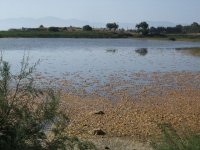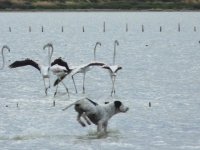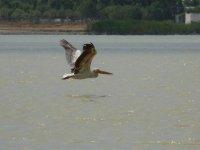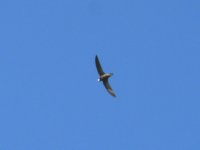This was a family holiday to the Psalidi area of Kos with my wife and 4 year old daughter. We stayed in the Hotel Sol Kipriotis Village which had the benefit of being less than 10 minutes walk to the entrance to the Psalidi wetland reserve.
The wetland is bi-sected by a causeway with reed beds to the north and a shallow lake to the south. A path runs around the whole perimeter of the reserve. The wetland is fenced and managed as a protected reserve with a visitor centre and a hide located on the causeway (which was permanently locked).
The benefit of this was that I could bird watch without the stress of worrying whether I was trespassing on somebody’s land. The Psalidi area is only mentioned in passing in the trip reports I had read from parties who based themselves in Tigaki. I had hopes that by making the area my regular patch for the week, that I could improve on the relatively sparse number of species reported in these reports from this area.
Having birded several times in the Med, I had no real target species, particularly as we had gone well outside the migration period. I did hold out some hope that I would find a roller which I had noticed was regularly reported in other areas of Kos in May. I was not certain whether this bird bred in Kos or simply passed through in numbers.
THE BIRDS
House sparrows were abundant around the hotel and any area with buildings nearby. Greenfinches were also present in numbers and hooded crow was the commonest large bird. The corvids were also represented by magpie and jackdaw.
Crested larks were present in numbers in areas of rough ground, fields and on the beach. Yellow legged were the only representative of the gulls I encountered. Olivaceous warblers were very common even in the hotel grounds but their skulking habits led to only the occasional glimpse. Cettis and Sedge were heard singing from the reed bed but not seen.. Hirundines and common swifts were a constant feature and included the occasional red rumped swallow.
The only wader seen in this area was a black winged stilt which gave confiding views from the sides of the lake. Also present on the lake were a pair of squacco herons which were seen regularly. Sadly, coot and mallard represented the only other water birds which I could locate on the lake which was disappointing.
My favourite area to bird was at the far southern end of the lake. From here you could look north across the lake through a gap in the foliage towards the hide. Looking south was a fallow field with several pylons running through it. It was on one of these pylons on the second day that I saw my one and only roller of the trip. This stunning bird posed for about 20 minutes allowing me to digiscope it badly from a distance of about 100 yards.
More common in this area were bee eaters which could be seen and heard throughout the reserve. Several bee eaters posed next to the roller on the pylon allowing views of two of Europe’s most colourful birds through the same eye piece view. They were joined by a little owl. .Turtle doves were seen on the pylons and also in a dead tree on the west side of the lake. Careful examination of the large house sparrow flock which favoured some disused bunkers, revealed a Spanish sparrow amongst their midst
Seeing the roller meant that the holiday was a success bird wise. However, I was disappointed with the lack of variety of species which I was able to locate. My hope of improving on the list of species previously reported didn’t materialise. The diversity of habitat and the good level of management of the reserve had promised more.
With assurances of a comfortable sun bed on a lovely beach, I was able to persuade my wife to spend our last two days in Tigaki which is a more renowned birding destination. I will cover my experience of Tigaki in a supplementary report.
As we waited outside the hotel for our transport to arrive at 23:00 on our last night, my wife heard a scops owl calling from outside of the hotel reception area. Anyone who has looked for scops in the night will know that hearing the call is the easy part and actually locating the bird is a whole different ball game. Alas our mini bus arrived within minutes and the owl went unseen.
The wetland is bi-sected by a causeway with reed beds to the north and a shallow lake to the south. A path runs around the whole perimeter of the reserve. The wetland is fenced and managed as a protected reserve with a visitor centre and a hide located on the causeway (which was permanently locked).
The benefit of this was that I could bird watch without the stress of worrying whether I was trespassing on somebody’s land. The Psalidi area is only mentioned in passing in the trip reports I had read from parties who based themselves in Tigaki. I had hopes that by making the area my regular patch for the week, that I could improve on the relatively sparse number of species reported in these reports from this area.
Having birded several times in the Med, I had no real target species, particularly as we had gone well outside the migration period. I did hold out some hope that I would find a roller which I had noticed was regularly reported in other areas of Kos in May. I was not certain whether this bird bred in Kos or simply passed through in numbers.
THE BIRDS
House sparrows were abundant around the hotel and any area with buildings nearby. Greenfinches were also present in numbers and hooded crow was the commonest large bird. The corvids were also represented by magpie and jackdaw.
Crested larks were present in numbers in areas of rough ground, fields and on the beach. Yellow legged were the only representative of the gulls I encountered. Olivaceous warblers were very common even in the hotel grounds but their skulking habits led to only the occasional glimpse. Cettis and Sedge were heard singing from the reed bed but not seen.. Hirundines and common swifts were a constant feature and included the occasional red rumped swallow.
The only wader seen in this area was a black winged stilt which gave confiding views from the sides of the lake. Also present on the lake were a pair of squacco herons which were seen regularly. Sadly, coot and mallard represented the only other water birds which I could locate on the lake which was disappointing.
My favourite area to bird was at the far southern end of the lake. From here you could look north across the lake through a gap in the foliage towards the hide. Looking south was a fallow field with several pylons running through it. It was on one of these pylons on the second day that I saw my one and only roller of the trip. This stunning bird posed for about 20 minutes allowing me to digiscope it badly from a distance of about 100 yards.
More common in this area were bee eaters which could be seen and heard throughout the reserve. Several bee eaters posed next to the roller on the pylon allowing views of two of Europe’s most colourful birds through the same eye piece view. They were joined by a little owl. .Turtle doves were seen on the pylons and also in a dead tree on the west side of the lake. Careful examination of the large house sparrow flock which favoured some disused bunkers, revealed a Spanish sparrow amongst their midst
Seeing the roller meant that the holiday was a success bird wise. However, I was disappointed with the lack of variety of species which I was able to locate. My hope of improving on the list of species previously reported didn’t materialise. The diversity of habitat and the good level of management of the reserve had promised more.
With assurances of a comfortable sun bed on a lovely beach, I was able to persuade my wife to spend our last two days in Tigaki which is a more renowned birding destination. I will cover my experience of Tigaki in a supplementary report.
As we waited outside the hotel for our transport to arrive at 23:00 on our last night, my wife heard a scops owl calling from outside of the hotel reception area. Anyone who has looked for scops in the night will know that hearing the call is the easy part and actually locating the bird is a whole different ball game. Alas our mini bus arrived within minutes and the owl went unseen.









